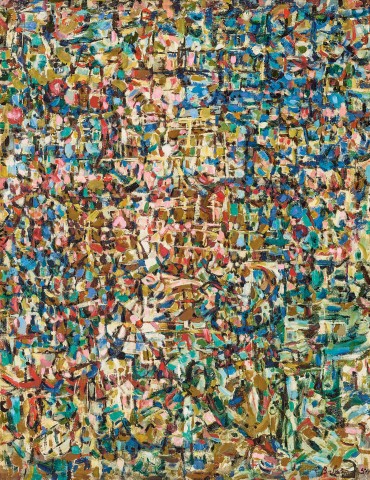UNTITLED (NON-OBJECTIVE PAINTING), 1954
RALPH BALSON
oil on composition board
91.0 × 69.5 cm
signed and dated lower right: R Balson 54
Peter Balson, Sydney, the artist’s son
Private collection, Sydney, acquired from the above, c.1960
Thence by descent
Private collection, Sydney
Throughout his career Ralph Balson tirelessly sought a process of abstract painting that would respect the physical qualities of paint while illustrating what he would call the ‘ineffable’: the sublime and invisible forces of the universe. 1 This pursuit led him through a disciplined, logical progression of different styles of abstract painting – from the planar geometry of his Constructive works, to a painterly fragmentation of the ‘Non-Objective’ paintings, and finally, the automatic Matter Paintings. In the early 1950s, the first of these tipping points, Balson released himself from the impersonal and serene rigour of his constructivism and allowed himself to embrace the ever-changing fluidity of the universe. His new style of lyrical and painterly abstraction was one that Daniel Thomas qualified as the ’climax of his career’, created at precisely the time when Romantic abstraction became fashionable in the circles of Contemporary art in Sydney.2
This dramatic adoption of a fractured, kaleidoscopic surface was prefigured in Balson’s pastel works on paper, which were first exhibited at Macquarie Galleries in Sydney in 1952. James Gleeson described these works at the time as a ’descent into a fantastic and delightful jungle. Here in these pastel labyrinths the forms are shattered into a thousand particles which are disposed over the surface in patterns of great complexity and variety.’3 While it has been generally accepted by scholars that Balson did not put these restless expressions of overall abstraction into practice in paint until 1955 at the earliest,4 this outstanding example is clearly signed and dated lower left – R Balson, 54 – and handsomely housed in its original 1950s wooden frame. This is a rare and important example in paint of the divergent principles Balson had hitherto only explored on paper, an extraordinarily early outlier in Balson’s painterly investigation into flux, the ever-accelerating pace of modern progress.
This Non-Objective is also aesthetically liminal, presenting (in contrast to later Non-Objective paintings) a wide variety of brush strokes, and a grid-like lattice painted below the surface of these applied daubs. Whipping criss-crossed strokes and smatterings of pure colour are evenly and seemingly randomly distributed across the board to create movement and dynamism. With no clear focal point, the marks of the finely mottled surface coalesce in the centre and dissipate towards the edges of the support. The eye is drawn around the painting, attracted by joyful and bold tonal associations, such as the profusion of cobalt in the upper righthand corner. While Balson’s pastel Non-Objectives worked against the tooth of the paper, the dry brushstrokes of this painting are applied to the coarse surface of the composition board, breaking up the pigment into further fractured minutiae.
A precocious disciple of international Modernist theory, Balson focused on the planar quality of the picture’s surface, producing some of the first purely abstract works in Australia. He had initially been exposed to notions of French Art Informel and New York Abstract Expressionism through Grace Crowley’s correspondence with friends overseas, and these were further solidified with the 1953 Art Gallery of New South Wales exhibition, French Painting Today, which encouraged many young Sydney painters to embrace abstraction.
Non-Objective painting was created at a pivotal point in Balson’s career. While he remained for most of his life a quiet man removed from the social scene of the Sydney art world, it was in 1953 that Balson finally started to receive a solid critical reception. Not only did the Art Gallery of New South Wales acquire one of his Constructive Paintings for their permanent collection, but the Conference of Interstate Gallery Directors (a meeting of the directors of Australia’s major art museums) selected two of his paintings, both from the 1950s, to be included in a major diplomatic exhibition in London of the best contemporary Australian Art, Twelve Australian Artists, alongside established artists Russell Drysdale, Sidney Nolan and Arthur Boyd.5
1. Adams, B., ‘Metaphors of Scientific Idealism: The theoretical background to the paintings of Ralph Balson’ in Bradley, A. and Smith, T. (eds), Australian Art and Architecture: Essays presented to Bernard Smith, Oxford University Press, Melbourne, 1980, p. 188
2. Thomas, D., ‘Ralph Balson’, Art and Australia, vol. 2, no. 4, March 1965, p. 257
3. Gleeson, J., ‘Abstract Art Show Exciting’, The Sun, Sydney, 21 May 1952, p. 48
4. Free, R., Balson Crowley Fizelle Hinder, AGNSW, Sydney, 1966, p. 9; Thomas, D., op. cit.,, p. 258; Adams, B., Ralph Balson: A Retrospective, Heide Park and Art Gallery, Melbourne, 1989, p. 52; Taylor, E., Grace Crowley, Being Modern, National Gallery of Australia, Canberra, 2006, p. 50
5. Thomas, D., ‘Ralph Balson and Gallery A’, Gallery A Sydney 1964 – 1983, Campbelltown Arts Centre, New South Wales, 2009, p.106
LUCIE REEVES-SMITH
